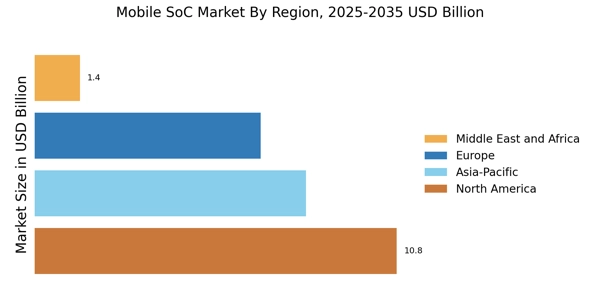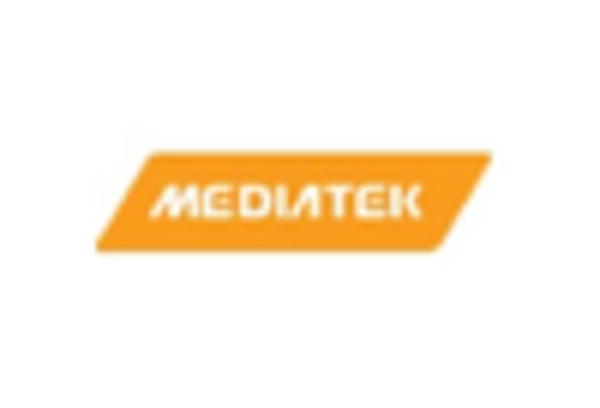Emergence of IoT Devices
The Mobile SoC Market is being significantly impacted by the emergence of Internet of Things (IoT) devices, which are becoming increasingly prevalent in various sectors. The proliferation of IoT applications, ranging from smart home devices to industrial automation, is driving the demand for efficient and versatile SoCs. By 2025, the number of connected IoT devices is projected to exceed 30 billion, creating a substantial market for mobile SoCs that can support these applications. Manufacturers are focusing on developing SoCs that offer low power consumption and high performance, catering to the unique requirements of IoT devices. This trend is likely to foster innovation within the Mobile SoC Market, as companies strive to create solutions that can seamlessly integrate with the expanding IoT ecosystem.
Advancements in 5G Technology
The Mobile SoC Market is significantly influenced by the rapid advancements in 5G technology, which is reshaping the telecommunications landscape. The deployment of 5G networks is expected to enhance data transfer speeds and reduce latency, thereby enabling a new era of mobile applications and services. As of 2025, it is estimated that 5G subscriptions will surpass 1.5 billion globally, necessitating the development of SoCs that can efficiently support these high-speed networks. Manufacturers are increasingly focusing on integrating 5G capabilities into their SoC designs, which may lead to improved performance and user experiences. This shift towards 5G is likely to drive innovation within the Mobile SoC Market, as companies seek to capitalize on the opportunities presented by this transformative technology.
Rising Demand for Mobile Devices
The Mobile SoC Market is experiencing a notable surge in demand for mobile devices, driven by the increasing reliance on smartphones and tablets for daily activities. As of 2025, the number of smartphone users is projected to reach approximately 6.8 billion, indicating a substantial market for mobile system-on-chip solutions. This trend is further fueled by the growing adoption of mobile applications across various sectors, including education, healthcare, and entertainment. Consequently, manufacturers are compelled to innovate and enhance their SoC offerings to meet the diverse needs of consumers. The competitive landscape is intensifying, with companies striving to deliver high-performance, energy-efficient solutions that cater to the evolving preferences of users. This rising demand is likely to propel the Mobile SoC Market forward, creating opportunities for growth and development.
Growing Focus on Artificial Intelligence
The Mobile SoC Market is witnessing a growing focus on artificial intelligence (AI) integration within mobile devices. As AI technologies become more prevalent, there is an increasing demand for SoCs that can efficiently process AI workloads. By 2025, it is anticipated that the AI chip market will reach a valuation of over 30 billion, highlighting the importance of AI capabilities in mobile SoCs. This trend is prompting manufacturers to develop specialized AI processing units within their SoCs, enabling enhanced functionalities such as improved image processing, voice recognition, and personalized user experiences. The integration of AI into mobile devices is likely to redefine user interactions and drive further growth in the Mobile SoC Market, as consumers increasingly seek smarter and more responsive devices.
Increased Investment in Research and Development
The Mobile SoC Market is benefiting from increased investment in research and development (R&D) by key players. As competition intensifies, companies are allocating significant resources to innovate and enhance their SoC offerings. This focus on R&D is crucial for developing advanced technologies that can meet the evolving demands of consumers and businesses alike. In 2025, it is estimated that R&D spending in the semiconductor industry will reach approximately 80 billion, underscoring the commitment to innovation. This investment is likely to lead to breakthroughs in performance, energy efficiency, and integration of new technologies within mobile SoCs. As a result, the Mobile SoC Market is poised for continued growth, driven by the relentless pursuit of technological advancement.

















Leave a Comment